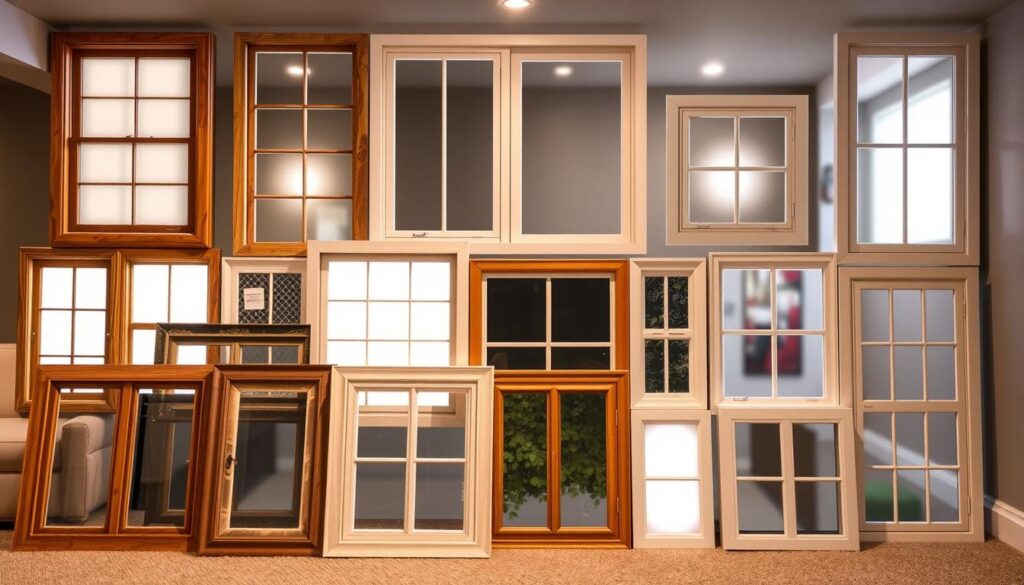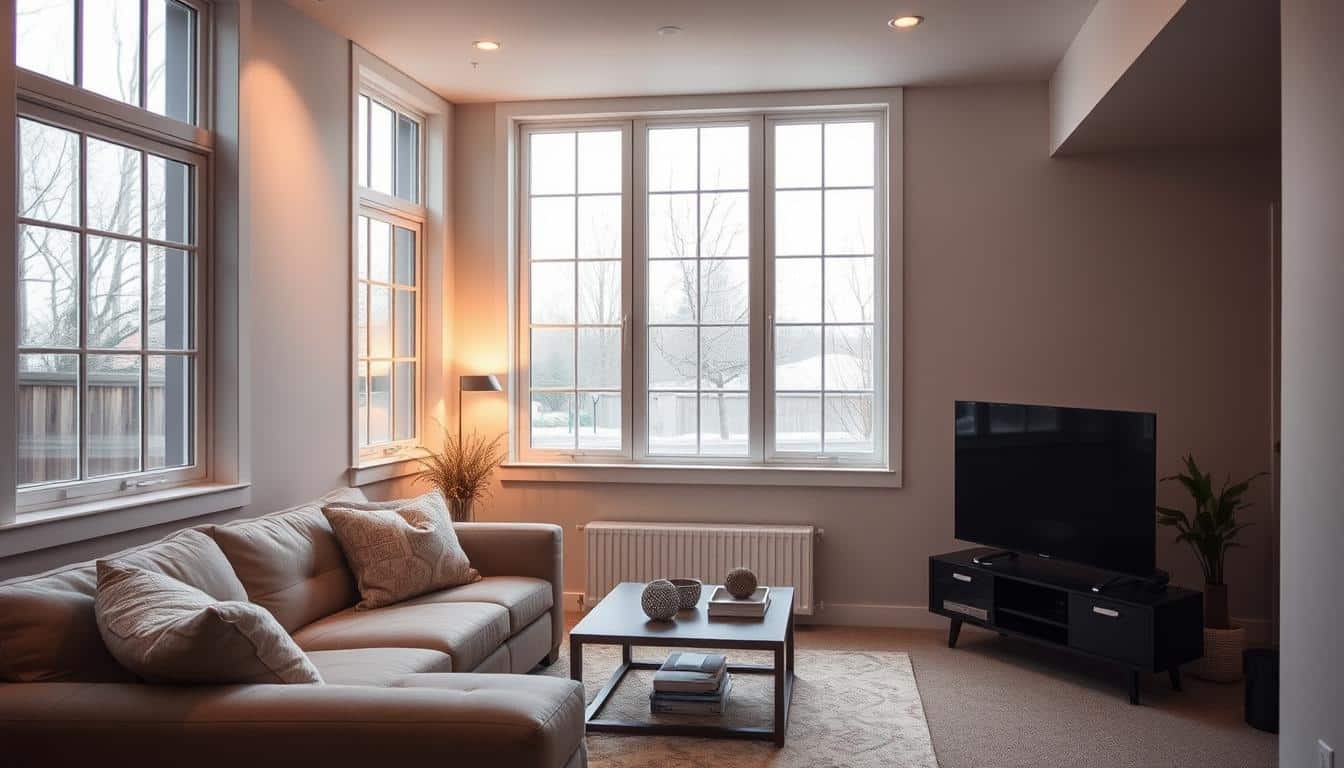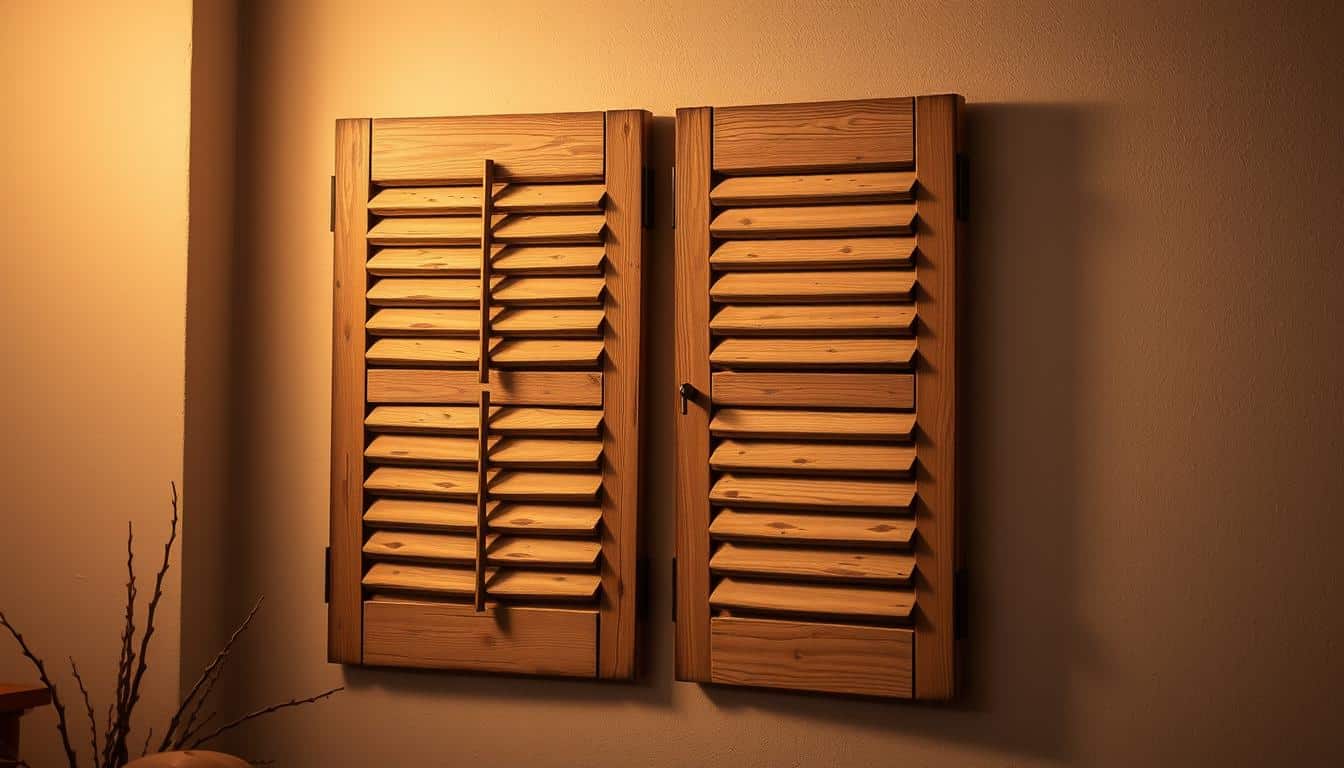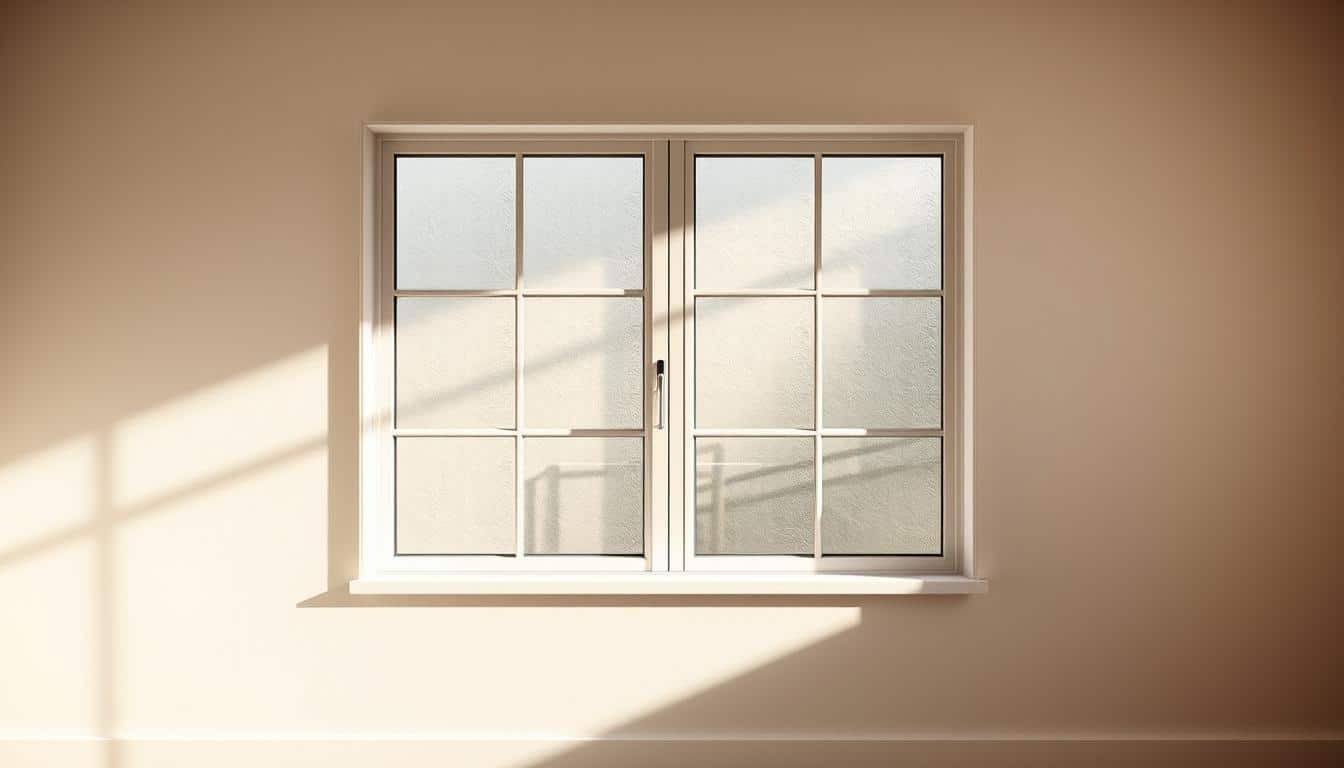Anúncios
Turning basement apartments into warm, welcoming places might seem tough, especially with little sunlight. Luckily, inventive fake window concepts have become great tools for decorating homes. They make these commonly dim spaces look better and feel friendlier.
As cities get more crowded and homes smaller, many look for smart, eye-catching ways to better their spaces. This has made faux windows a hit for those wanting to improve their home vibe.
Anúncios
Understanding the Need for Faux Windows in Basements
Living in a basement can be both good and challenging. Many choose basement apartments for their lower costs and great locations. These places are especially popular in cities where living is expensive. However, basements often don’t have windows, which can make living there less enjoyable.
Why Choose a Basement Apartment?
People choose basement living for many reasons. Key factors include:
Anúncios
- Lower rental costs compared to above-ground units
- Proximity to city amenities and public transport
- Potential for larger living spaces than typical apartments
Students, young professionals, and small families find these features attractive.
Common Challenges in Windowless Rooms
But there are challenges in rooms without windows. Common issues include:
- Lack of natural light, which can affect mood and productivity
- Feelings of confinement due to limited views
- Increased risk of mold and dampness without proper ventilation
To make basement living better, using faux windows can be a great solution. They help make the space feel more open and pleasant.
Innovative Fake Window Ideas for Basement Apartments
Turning a dark basement into a welcoming area is doable with clever fake window ideas. DIY faux window efforts are key in making basement apartments look and feel better. With some creativity, pretending there’s natural light is possible using designs that are both simple and complex.
DIY Faux Window Projects
Starting DIY faux window projects lets homeowners make their space unique while solving lighting issues in basements. They can use different materials, like:
- Wood frames painted to look like real windows
- Wall decals showing outdoor views
- 3D panels adding depth and texture
By mixing these elements, you can create impressive fake windows. Adding materials that look like glass can make the illusion even stronger. This trick pulls the eye and opens up the room.
Using LED Lights for Realistic Illumination
Adding LED lights into these projects can change a room completely. LED strips or panels, placed well, can make it seem like sunlight is coming through a window. This creates a cozy glow. You can:
- Put lights behind fake windows for a shining effect
- Adjust light brightness for different feelings
- Use LED lights that change colors to simulate different times of the day
These creative lighting ideas offer a great fix for rooms without windows. They make the space brighter and more pleasant to be in, increasing how much you enjoy your basement apartment.
Types of Faux Windows to Consider
Looking to brighten up your basement? Check out different faux windows. You can choose from backlit faux windows and wall murals. Both options can make any room look better.
Backlit Faux Windows
Backlit windows turn a plain wall into something special. They use lights to mimic real sunlight. This trick makes rooms feel bigger and more welcoming.
They give off a warm glow. This can totally change how a room feels.
Illusionary Window Murals
Illusionary window murals are like art for your walls. They can show peaceful nature scenes or busy city views. You pick what you like best.
These murals make a room seem more open. They’re a great option for adding style to your basement.
Creating Your Own Faux Window
A faux window can make a dark basement feel welcoming and bright. To make one, you need the right supplies and a step-by-step guide. Here’s what you’ll need and how to do it for your faux window project.
Materials You Will Need
- Frames (wood or lightweight metal)
- Acrylic or Plexiglass covers
- LED strip lights
- Paint for the frame
- Diffusing material like cornstarch
- Wall adhesive or mounting tape
- Tools (screwdriver, drill, paintbrush)
Step-by-Step Guide to Building Your Faux Window
- Measure the space where the faux window will be installed.
- Cut the frame material to create a rectangular outline.
- Assemble the frame and secure it using screws or adhesive.
- Attach the acrylic or Plexiglass cover to the frame.
- Paint the frame for an attractive finish, allowing time to dry.
- Set up the LED strip lights behind the acrylic cover. Ensure they are securely adhered.
- Use cornstarch or another diffusing material over the LED lights for a soft glow.
- Mount the faux window in your desired location using wall adhesive.
Lighting Techniques to Enhance the Fake Window Effect
Proper lighting is key to making fake windows look real. It can make a basement feel brighter and more welcoming. LED panels are a great choice here. They offer soft light that’s perfect for different activities and feelings.
LED panels are perfect for creating a natural sunlight effect. They give off a soft, spread-out light. This makes rooms without windows feel more inviting. When picking these panels, the color of the light is important too. The right color can make the mood just right. Warm colors can make a space cozy, while cool colors feel more alive.
- Identify the desired mood for the space.
- Choose LED panels that match this mood with appropriate color temperatures.
- Experiment with different placements of the panels to optimize light distribution.
These strategies help make your space look better with a fake window. It improves how your basement looks and feels.
Framing the Faux Window for a Realistic Look
Making a faux window look real starts with the framing. You can pick from different styles and materials. This choice changes how it looks a lot, making it fit perfectly with your house’s style.
Types of Frames You Can Use
Think about these materials when choosing a frame:
- Wood: Gives a rustic, traditional look that perfectly complements various interior styles.
- PVC: A low-maintenance option that can mimic the appearance of wood without the upkeep.
- Metal: Provides a modern and sleek appearance, ideal for contemporary settings.
- MDF: A versatile material that can be easily painted to match any color scheme.
Decorative Touches to Add Style
Add these touches to make your faux window more stylish:
- Molding: Crown or baseboard molding can frame the faux window, adding depth and an architectural element.
- Curtains or Blinds: Adding fabric softens the look and brings a homey feel to the space.
- Window Sills: A faux window sill adds realism and offers a place for decorative items or plants.
Enhancing the Faux Window with Curtains and Blinds
Adding the perfect touch to a faux window is about more than the frame and lights. The right curtains and blinds can make it look deeper and prettier. They change the room and make it more useful too.
Why Curtains Matter
Curtains make a room feel welcoming. They make plain walls look nicer by adding warmth and texture. Curtains that let light filter through make it feel like sunlight is coming in, just like from a real window. Think about these ideas when choosing curtains:
- Lightweight materials for a breezy feel
- Heavy drapes for added warmth and insulation
- Patterns to create visual interest and tie the room together
Types of Blinds That Complement Faux Windows
Blinds are great for basement apartments. They keep your space private and let you control the light. Picking the right blinds can make your faux window look better and work better. Here are some types to consider:
- Roller blinds for a sleek, modern look
- Vertical blinds to cover larger faux windows with ease
- Roman shades for a soft and elegant finish
Fake Windows as a Modern Interior Design Trend
Today, fake windows are becoming a big trend in interior design. They’re popular because they can make rooms without much natural light feel brighter. Fake windows make spaces seem more open, helping rooms feel larger and more welcoming. By adding well-made fake windows, homes get a boost in style and comfort.
How Faux Windows Influence Room Aesthetics
Fake windows can really change how a room feels. They add a sense of depth and light, making spaces seem airier. With so many ways to customize, you can match them with any style. Choosing the right lighting, frames, and decor lets these windows blend perfectly with your home. It’s a creative and practical solution for rooms without windows.
Real-Life Examples From Interior Designers
Many interior designers love using fake windows in cool ways. For instance, a basement lounge was turned cozy with lighted fake windows. It made the space perfect for relaxing. In a modern office, fake windows with mural designs added an interesting touch, making up for no real views outside. These examples show that fake windows can be stylish and relevant in design today.
Cost Considerations for Faux Windows
When planning faux windows, it’s smart to know about costs. This helps you make smart choices. There are many options to fit your budget, from DIY to professional help. Understanding the costs involves looking at cheap DIY options and comparing DIY with professional work.
Budget-Friendly DIY Options
DIY projects can save money and let you be creative. Here are ways to save:
- Use materials like plywood and paint for a simple framed look.
- Consider wallpaper or prints that mimic outdoor views for murals.
- Incorporate LED strips to add lighting without high electrical costs.
- Utilize repurposed materials from local thrift stores or salvage yards.
Cost Comparison: DIY vs. Professional Installation
Choosing DIY or professional help affects your budget a lot. DIY might cost $50 to $200, depending on what you use. Professional work could cost $400 to $1,500. Prices change based on:
- The complexity of the faux window design.
- Materials required for the installation.
- Labor costs associated with professional services.
Understanding these costs helps in picking the best option for adding faux windows.

Conclusion
Looking into faux window ideas shows how they can change basement areas for the better. These design tricks, like backlit faux windows and wall murals, fight the usual darkness of basements. They make the space look better and feel more welcoming.
Being creative is key to changing the look and feel of your home. People can make their spaces their own by tackling DIY projects. This adds a personal touch and warmth to places in the home that are often ignored.
Adding faux windows can greatly improve the vibe of basement apartments. This makes living areas bright, lively, and inviting. It changes how we see such spaces.
FAQ
What are fake windows and how can they be used in basement apartments?
Why are basement apartments becoming more popular?
What are some common issues faced in windowless environments?
What types of DIY projects can I create for fake windows?
How can LED lights enhance the effect of faux windows?
What materials do I need to create my own faux window?
What lighting techniques should I consider for my faux windows?
What framing options are available for my faux windows?
How can curtains and blinds enhance my faux windows?
How are faux windows influencing modern interior design?
What are the cost considerations for creating faux windows?
Content created with the help of Artificial Intelligence.



